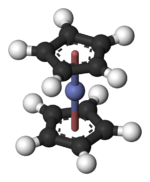Cobaltocene
Cobaltocene is prepared by the reaction of sodium cyclopentadienide (NaC5H5) with anhydrous cobalt(II) chloride in THF solution.
[4] Cobaltocene has 19 valence electrons, one more than usually found in organotransition metal complexes such as its very stable relative ferrocene.
Many chemical reactions of Co(C5H5)2 are characterized by its tendency to lose this "extra" electron, yielding an 18-electron cation known as cobaltocenium: The otherwise close relative of cobaltocene, rhodocene does not exist as a monomer, but spontaneously dimerizes by formation of a C–C bond between Cp rings.
This substituent effect is, however, overshadowed by the influence of the metal: changing from Fe to Co renders the reduction more favorable by over 1.3 volts.
Treatment of Co(C5H5)2 with carbon monoxide gives the cobalt(I) derivative Co(C5H5)(CO)2, concomitant with loss of one Cp ligand.



